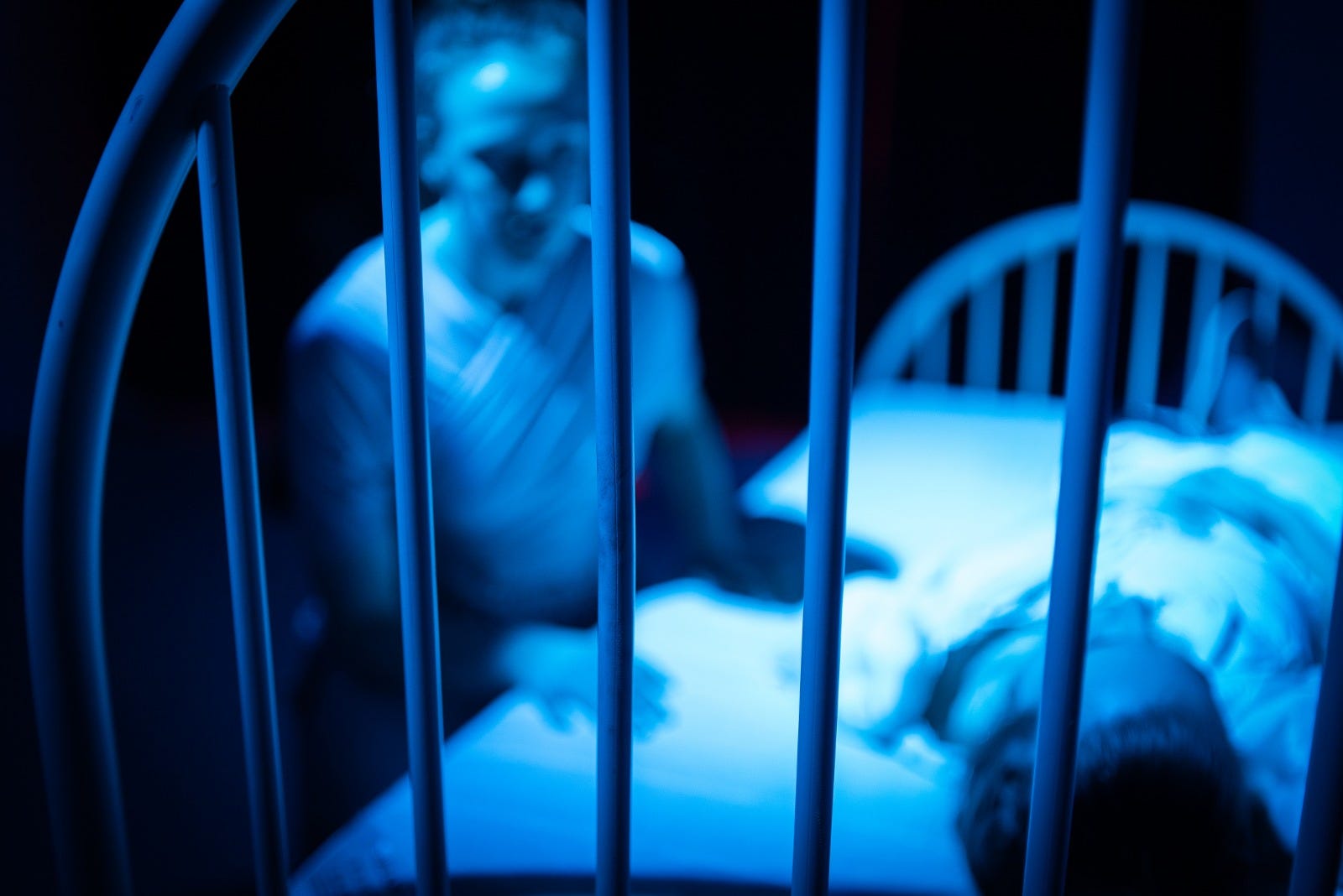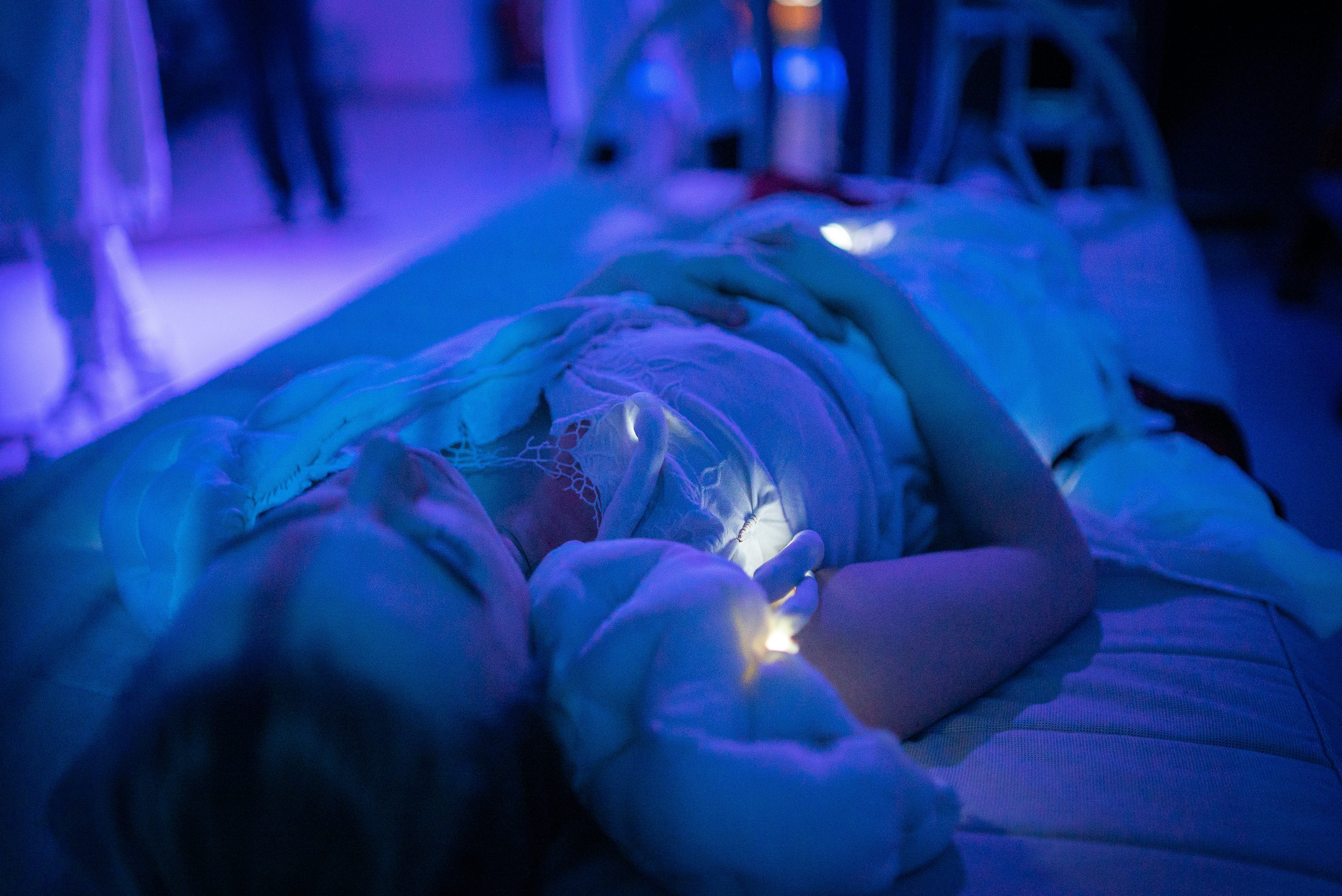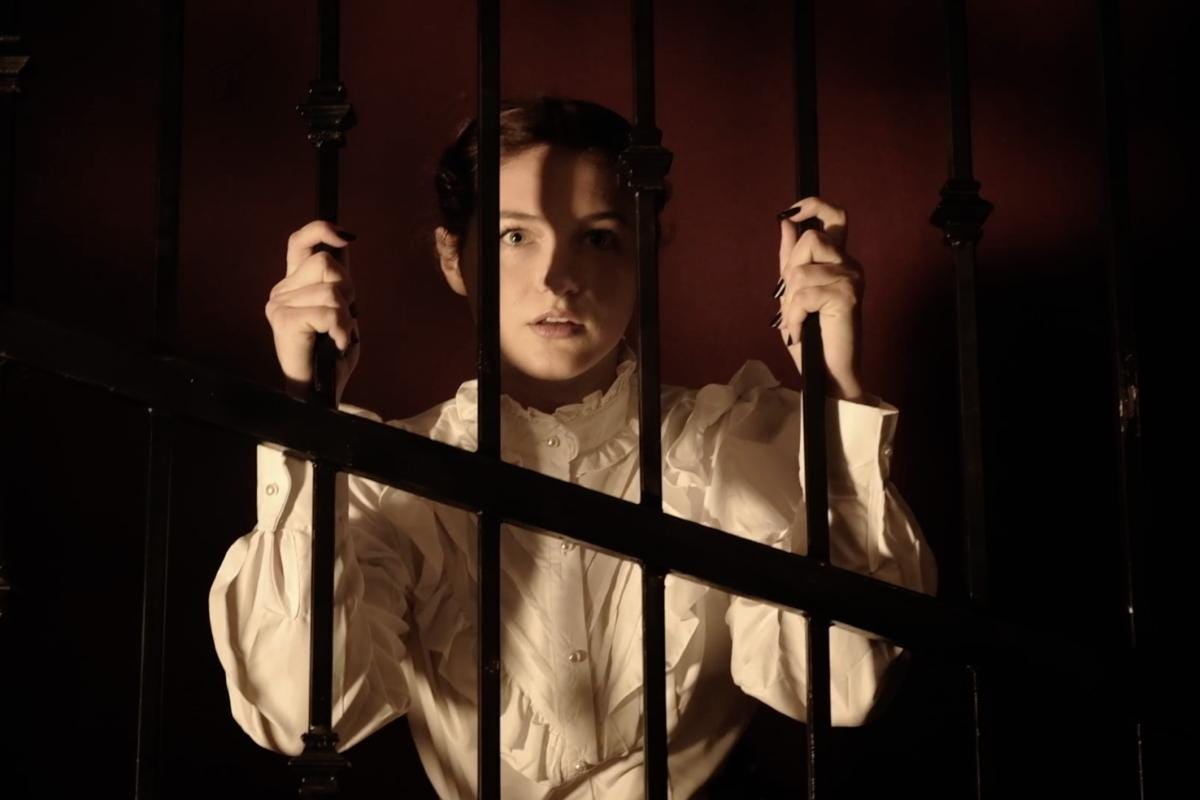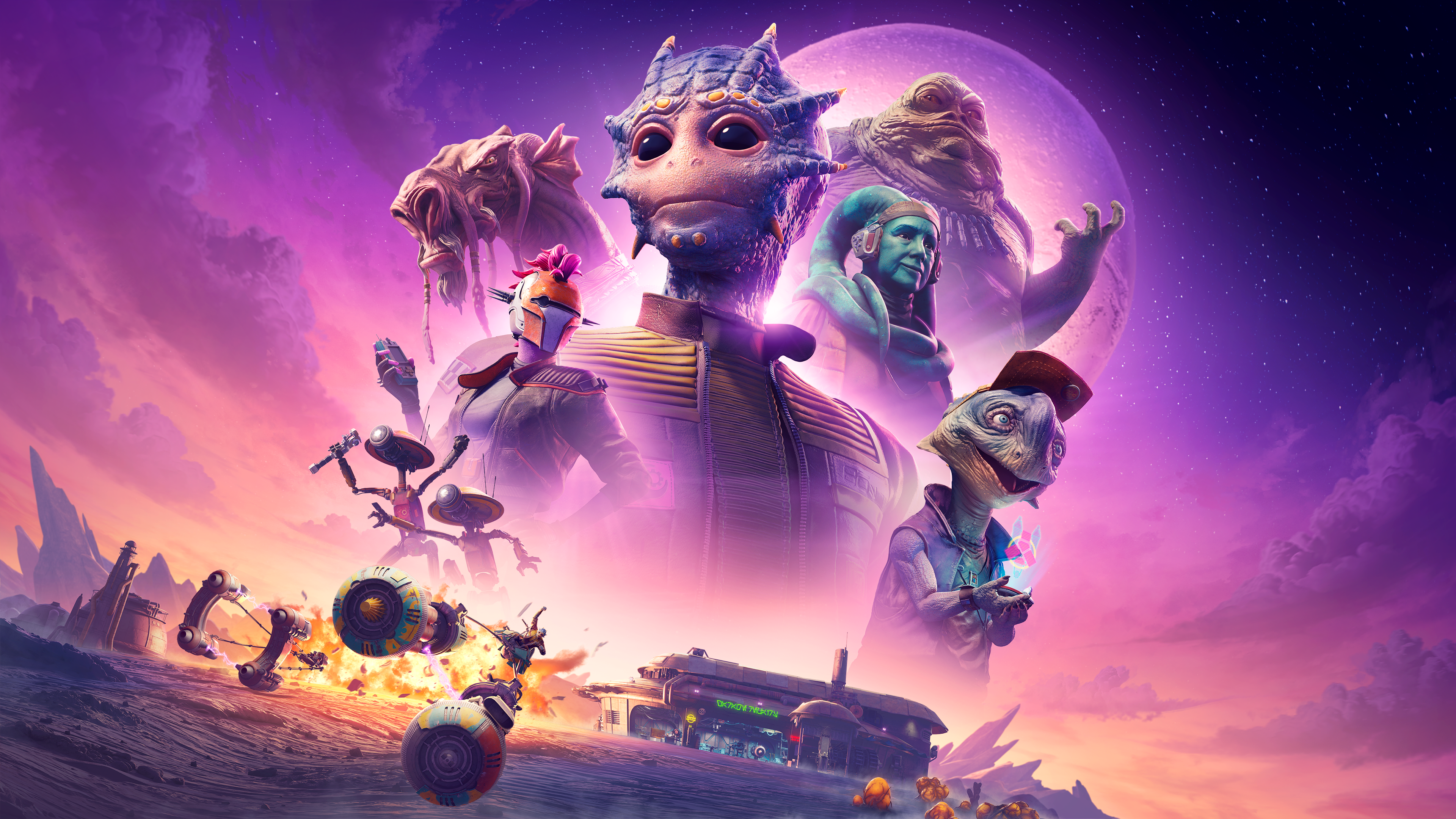
I am handed a vial containing a strange clear liquid. As I twist and move the tube, the liquid doesn’t move quite right; it’s hard to see in the dimly lit warehouse/art space that I am standing in. I mustn’t drink it yet, because I must wait for the doctor to arrive. I am impatient after cooling my heels for nearly 30 minutes, having followed the pre-show instructions quite carefully (unlike other immersive shows, this one has no bar). I find myself holding this vial along with the other thirty or so attendees, who are each holding theirs, as we have been invited to hear the results of the doctor’s latest dream study. This is to be a celebration of what he has discovered. But I am wary of what I may discover here.
As we wait, the event hosts are a fun distraction. There are two lab coat-wearing scientists, both acting like mad professors from Rocky Horror Picture Show—acting campy and laughing maniacally. They divide us into groups in preparation for the celebration (more on that later). But the doctor? Nowhere to be found. Suddenly the tone of the evening completely shifts. The lights dim to darkness. Strange spectres emerge and push us into a large circle around the edges of the warehouse. We watch curiously as they dance and weave in the center, with our hosts joining in the crazy spectacle. In the darkness, I see that the figures wear white leotards and are lit up by the headlamps that each of them is wearing. The lights are blinding to the audience as they twist and turn. A woman, who is dressed like a 20th century nanny, has appeared, and seems to have a strange connection to one of the scientists, a woman.
If you’re confused by now, after this fever dream of an opening, I must sadly report that I was as well. And clarity eluded me for the rest of the experience. We soon break up into small groups to view a series of individual, disconnected, non-sequential scenes. I see an empty tech booth where two of the spectres are dancing with each other. The room is decorated with white plastic bags hanging from every tile of the roof, and along the walls, and on the ground. The two dancers seem not to notice us. The female scientist comes running up to us, and tells us suddenly that we have to go. Why? I’m not quite sure.

Next is a scene of performers sitting on a large inflatable swan, blowing bubbles with a large bubble sword. We are each given a sword to help with the bubblemaking. It’s all very bizarre. “Do you remember your dreams?” we are asked. We are invited to turn to look back to where we have just been, to see the previous scene from a new perspective, although from this angle, it is just a fleeting limb going past a window. Then, much more harshly and threateningly, we are asked “Do your dreams remember you?” It’s a nice moment, but it abruptly ends. “Get out!” they scream. And so we do. Being cut out of what was perhaps the most intriguing scene of the night left me feeling very dissatisfied.
We are ushered next into a bedroom scene, where the nanny from earlier instructs one of the audience members to get into the bed. She shares a bedtime story with us: that of a young girl kidnapped by faeries and replaced by a copy of herself. As one of the people not in the bed, I’m unsure who is really being addressed here, or what our role is in this scene, or for that matter what the point of it all was.
I soon find myself back in the main performance area as the groups merge again. We form a large circle. The spectres perform a whirling dance in the space. I observe a strong connection between the female scientist and the nanny (or is it her mother?), staring into each other’s eyes. They keep trying to reach other, but are always pushed out of the way by the other performers. Now on wheels, the bed from the previous scene accompanies the whirlwind of movement. As the two finally reach each other, the scientist dies, falling onto the bed. The spectres push her around the room in a funeral procession; we are handed roses, and invited to place them on the corpse.
Wait, is she the girl from the story? What’s their relationship? What’s the connection here?
I ponder this as the show comes to a conclusion, and as the whole scene that we just witnessed now plays in reverse, double time, as the performers run backwards around the space, getting worryingly close to hitting the human circle. The doctor stands on the bed, and is speaking to the audience. However, the sound is actually coming through the speaker system, heavily distorted with reverb. The effect is super creepy but I am completely unable to tell is being said. I presume that this speech was some great revelation — some beautifully crafted monologue — but it was completely lost on the audience. The lights suddenly go out, and the performers rush off, leaving the confused patrons to wonder what we just witnessed.

Nocturnes is undeniably French in its approach, which should come as no surprise given the production team behind the show. The movement of the performers, the lighting design, and certainly the sound design are all incredibly reminiscent of modern French cinema. It’s all a little creepy, but borders on the nonsensical. Experiencing the piece feels like one of those assigned films in college that you have to watch, just say that you’ve watched it. Comprehension and enjoyment of the material is not necessarily the goal. As the production came to a close, I looked around at the faces of my fellow audience members. Their faces ranged from confusion to bemusement, much like mine. What was the point of it all? What are they trying to say?
Get Edward Mylechreest’s stories in your inbox
Join Medium for free to get updates from this writer.
SubscribeSubscribe
My big concern here is that the production values style over substance. Not all shows have to have a clear through line, and I’m certainly not suggesting that shows should dumb down content for their audiences or connect the dots for us. But given the unmooring from the traditional trappings of theatre, in an immersive show, the audience needs to have “something” to cling onto in order to stay connected, emotionally and narratively — a story they already know, an environment that feels familiar or archetypal. Even in “solve the mystery” shows, a narrative isn’t necessarily clear at first glance, but the frameworks and structures are familiar. Here the mystery itself is the rope, asking the audience to discover and piece it all together: a series of unrelated dream sequences, as we were given here, does not give us anything to latch onto, nor does the whole offer more than the sum of its parts.
The “on rails” design of the show structure left something to be desired as well. The idea of a “dark ride” attraction is that the audience are on specific tracks to guide them through the experience. The audience arrives; they are divided into groups; each member is on a specific track, and away we go. Knowing how to successfully navigate this is a challenge for creators, and unfortunately Nocturnes did not rise to the occasion. Upon arrival, a bright neon sticker was placed on us to signify what group we were to be in. We must stay in these groups, as it was the “doctor’s orders.” It was clunky, but it worked. However, after each individual scene happened, I received a different colored sticker and group assignment. By the end of the evening, I had three separate stickers on my clothing and had switched groups multiple times — but to what end? I’m not sure. All that this clunky mechanic did was to waste time, take the audience members completely out of the world, and annoy us.
As for the set, I have to note that the venue they chose was rather sizeable, but perhaps too ambitious for the piece. The team have done a decent attempt at transforming the warehouse, but it all feels very temporary. Scene locations are cordoned off with pipe and drapes. There is a giant poolside inflatable used as a “set piece.” A large orange construction ladder is left leaning up against the wall of the main space. The overall feeling I get is that this is a student piece rather than a full scale production. And neither the space nor the production value of the production feels on commensurate with the $100 asking price for tickets.
It is also disheartening is that several of the scenes in Nocturnes bore more than a strong resemblance to scenes that I have seen before in other shows. We here in New York City have been blessed to have had two long running immersive productions, which have proven to be amongst some of the most influential work worldwide. Sleep No More and Then She Fell are staples of the immersive landscape. But here is the thing: modern dance does not equal immersive theatre, and in exactly the same way, immersive theatre does not equal modern dance.
It is not the dance that makes these pieces immersive. Dance is used as a tool, a methodology, a paintbrush in order to tell the story. It is the world-building, the performer-to-audience interaction, as well as the use of the space, that makes these two pieces great examples of immersive storytelling. Being inspired by the two behemoths in our landscape is great, but they are not the be all and end all of immersive, and certainly do not represent must follow ideal practice for all shows. They are not recipes that have to be followed in order for your show to be “immersive.” They do not encompass the full richness of the possibility space of immersive.
I’m left with three main questions after my experience, ones which I hope would be of use to all immersive creators as they produce new work:
What is the story that you are trying to tell?
How are you going to tell it?
And, perhaps most importantly, what is the best way to tell this story and why does it have to be “immersive”?
Nocturnes has a lot of potential, and clearly has a very ambitious and creative team behind the project. All of the performers worked terrifically hard to maintain the world of the show, with Kelsey Rondeau in particular giving a striking performance as the elusive doctor. But it is a disservice to the performers, to the characters, and to your audience, to not give them something of substance to work with. I hope that the Nocturnes team will look at this run as a learning experience, and continue to grow and develop further.

Nocturnes has concluded its current run.
NoPro is a labor of love made possible by our generous Patreon backers. Join them today!
In addition to the No Proscenium web site, our podcast, and our newsletters, you can find NoPro on Twitter, Facebook, YouTube, Instagram, in the Facebook community Everything Immersive, and on our Slack forum.
Office facilities provided by Thymele Arts, in Los Angeles, CA.















Discussion